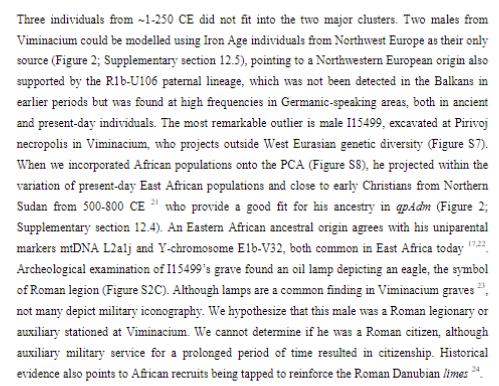50% of ancestry in modern day Yugoslavs, 25% in Albanians, & 40% in Bulgarians comes from invaders from northern & eastern Europe who arrived 200-700 AD. Romanian origins complex, with 50% of their ancestry from same NE European invaders as well as Asiatics from steppe. 







Roman Europe was very diverse at its height, with migrants from the more densely populated east settling in European cities. A sizable part of population of Viminacium in modern Serbia was of Middle Eastern origin, & they were wealthier than the locals. 


https://twitter.com/Peter_Nimitz/status/1281467465948528641?s=20



Two Germans & an African (probably from Meroe) were found buried in Roman graves in Serbia. The African was a legionary or auxiliary. 

https://twitter.com/Peter_Nimitz/status/1365912378257281025


Middle Eastern ancestry in Roman Balkans declined in 4th century AD. Sarmatians from the steppe and Germans from the north began to settle the Balkans, mixing with the pre-Roman populations who had held out in the relatively more homogenous countryside. 



Slavic invasions of the Balkans in the Dark Ages formed the modern populations of former Yugoslavia. South Slavs of the 10th century AD are very similar in ancestry to modern South Slavs. Slavic ancestry was disproportionately (75%) from women. 







Paper is one of several confirming what Juvenal, the Gracchi Brothers, Pliny the Elder observed - that the late Roman Republic's & early Roman Empire's eastern subjects comprised a noticeably high part of the Empire's European population. biorxiv.org/content/10.110…
The decline & fall of the Roman Empire featured mass die offs, with the Easterners concentrated in the cities disappearing. The rural pre-Roman populations survived and mixed with their German & Slav conquerors, forming modern Europeans nations.
https://twitter.com/Peter_Nimitz/status/1373799478520508416?s=20
• • •
Missing some Tweet in this thread? You can try to
force a refresh







































